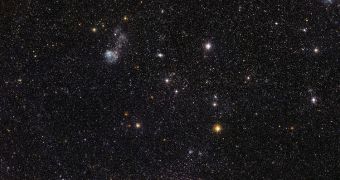In a new series of investigations, astronomers at the European Southern Observatory (ESO) managed to snap incredible new views of the Large Magellanic Cloud (LMC). This galaxy, one of the closest to the Milky Way, revealed a multitude of cosmic objects and phenomena taking place within it, which will most likely keep experts busy in deciphering them for a long time. The snapshots include globular star clusters, remnants of supernova explosions, as well as other phenomena pertaining to the birth and death of massive stars. Scientists hope to use the new data to gain additional insight into how galaxies grow and develop over time.
For the observations, the ESO team used the organization's Chile-based MPG/ESO 2.2-meter telescope of the La Silla Observatory. The Wide Field Imager (WFI) instrument was used for the actual photographs, as the tool has a tremendous resolve power. The LMC was chosen because of its proximity to our own galaxy. Measurements have determined that it lies about 160,000 light-years away, which makes it a prime targets for detailed observations. Even amateur astronomers can look at it using commercially-available instruments, and so it stands to reason that advanced telescope can peer deep within, and make out its secrets.
“The LMC lies in the constellation of Dorado (the Swordfish), deep in the southern sky and well placed for observations from ESO’s observatories in Chile. It is one of the galaxies forming the Local Group surrounding the Milky Way. Though enormous on a human scale, the LMC is less than one tenth the mass of our home galaxy and spans just 14,000 light-years compared to about 100,000 light-years for the Milky Way. Astronomers refer to it as an irregular dwarf galaxy. Its irregularity, combined with its prominent central bar of stars suggests to astronomers that tidal interactions with the Milky Way and fellow Local Group galaxy, the Small Magellanic Cloud, could have distorted its shape from a classic barred spiral into its modern, more chaotic form,” ESO experts write in a press release.
The new photo “covers a region of sky more than four times as large as the full Moon. The huge field of view of this camera makes it possible to see a very wide range of objects in the LMC in a single picture, although only a small part of the entire galaxy can be included. Dozens of clusters of young stars can be seen as well as traces of glowing gas clouds. Huge numbers of faint stars fill the image from edge to edge and in the background, more galaxies, far beyond the LMC, are visible,” the scientists conclude.

 14 DAY TRIAL //
14 DAY TRIAL //